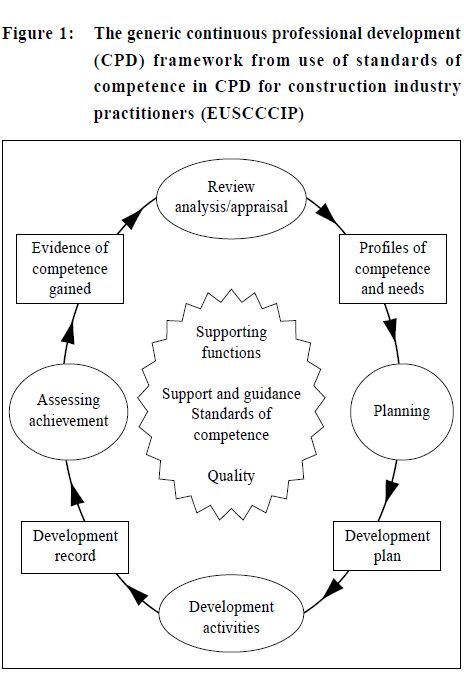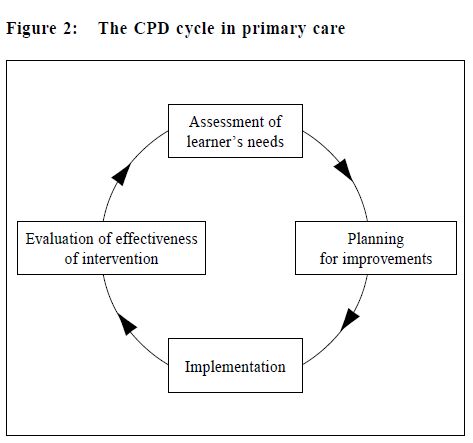
|
July 2001, Volume 23, No. 7
|
Discussion Paper
|
Continuous professional development (CPD): the link with qualityK W Chan 陳國維 HK Pract 2001;23:298-300 Summary Life-long education is a current topic in Hong Kong. This article explains the differences between traditional Continuing Medical Education (CME) and continuous Professional Development (CPD). It also explores the link between life-long education in the medical profession and quality of health care. 摘要 終生學習是香港近來的熱門話題。本文嘗試指出 傳統的延續醫學進修概念(CME)和持續專業發展概 念(CPD)之分別。繼而探討終生醫科專業學習和醫 療質素之關係。 Introduction Life-long education is a current topic in Hong Kong. There is life-long education in the teaching profession, the insurance profession, the legal profession and others. However, education itself does not necessarily lead to improvement of service in a profession. Quality, according to the Oxford Dictionary is "the standard of goodness". In the medical profession, it can be monitored under 3 areas: structure, process and outcome. Quality of health care has been discussed previously.1 For education to be effective in improving the quality of health care, it should be effective in improving the standard of goodness of the structure, the process and the outcome of our profession. Continuous professional development (CPD) systems (持續專業發展) are evolved in response to such needs. What is CPD? In the UK and Europe, CPD stands for continuing professional development. We use the word "continuous" instead of "continuing" to distinguish the special needs of the medical profession for ongoing and uninterrupted maintenance of ever-improving medical standards.2 CPD is not unique to the medical profession. The construction industry in Europe has had a CPD program for 15 years. Recently, an attempt was made to put this construction industry CPD program into a written framework. The project was funded by the Leonardo da Vinci programme of the European Commission. Four EU partner countries (Finland, Ireland, Portugal and the UK) and 14 EU partner organisations (of employers, of training providers, of professional bodies and of different categories of practitioners representing craftsmen, plumbers, builders, construction engineers, architects, surveyors etc.) had taken part. This two-year project was completed in November 1997 and produced a report: "use of standards of competence in CPD for construction industry practitioners (EUSCCCIP).3 A generic framework (Figure 1) was developed in the EUSCCCIP report, such that it could be modified by individuals, societies, organisations, employees and employers into different CPD systems to meet their needs. The framework was cyclical with 4-key processes: review, planning, developmental activities and assessing achievement. Each of these processess generated an output, which in turn was the input to the next component in the cycle (Figure 2).
Definition Continuous professional development (持續專業發展) is defined as the process of lifelong uninterrupted learning and self-improvement for individuals and teams, which enable medical professionals to expand and fulfill their potential in maintaining a high medical standard and an everimproving quality of care that meets the needs of patients.4 For the CPD system to be effective in the primary care setting, it should be learner-focused, of high medical standard, relevant to general/family practice and educationally effective. In order to link to quality, an ideal CPD system should cover the following areas: practice organisation, process and outcome. CME to CPD There is general agreement that continuing medical education (延續醫學進修) (CME) refers to those ongoing educational activities after graduation that keep individuals informed and up-to-date with medical knowledge. Some organisations, however, include management skills, teaching skills, appraisal skills, communication skills, information management and technology skills, etc into CME activities, whilst others consider CPD to be consisted of CME and these latter skills. To clarify the confusion, I would only classify those activities that involve the elements of Review-Planning- Developmental Activities-Assessing as CPD activities. This is to emphasise the more learner focused and active learning characteristics of CPD activities, in contrast to the more educator centred and passive learning characteristics of the traditional CME activities. Furthermore, evidence had shown that the traditional CME systems such as lectures and conferences had little direct impact on improving professional practice in contrast to learner focused systems such as practice-based intervention.5 Studies among general practitioners also showed that while CME and passive learning were good for assimilation of knowledge, they did not bring about professional changes.6 In contrast, selfdirected learning like audit was good for quality management in terms of changes.7 Evidence from the EU construction industry showed that the practitioners who did not keep upto- date with their CPD systems were more prone to accidents and strayed out of the profession quickly.3 The focus of our profession’s education system, therefore, should shift its emphasis from CME to the more effective and publicly accountable CPD. The Hong Kong Academy of Medicine has announced that all its "CME must evolve to CPD and all Colleges should take the necessary steps to accommodate this inevitability".8 The drawbacks The CPD system also has its drawbacks. As the CPD system is learner focused, different individuals may have different CPD cycle span, different scrutiny during assessment, and different motivation in planning and different advancement per implementation. The outcome for an individual after a CPD cycle may be very different from that of another even when both started the CPD cycle with the same level of competence. Given time, there will be great variation of standards among the profession. To maintain the standard of the profession at large, there must be a point assessment for all individuals to demonstrate his/her quality of performance in having reached an acceptable professional standard. This can be in the form of peer performance review or practice based assessment. The link with quality Gray proposed in his "CPD – the logic linking with performance"9 that in future the assessment of performance would be used increasingly in relation to CPD. Having defined performance first and then increasingly basing on CPD as the pathway to reach that measured level of performance would be more logical in quality assurance. Not only does it link directly with doctor performance but because the assessment criteria are evidence-based and patient based, it also links directly with the quality of care that patients receive. Key messages
K W Chan, FHKAM(Family Medicine), FRCGP, FRACGP, MICGP
Adjunct Associate Professor, The Chinese University of Hong Kong. Correspondence to : Dr K W Chan, G9, Bo Shek Mansion, 328 Sha Tsui Road, Tsuen Wan, N.T., Hong Kong.
References
|
|

